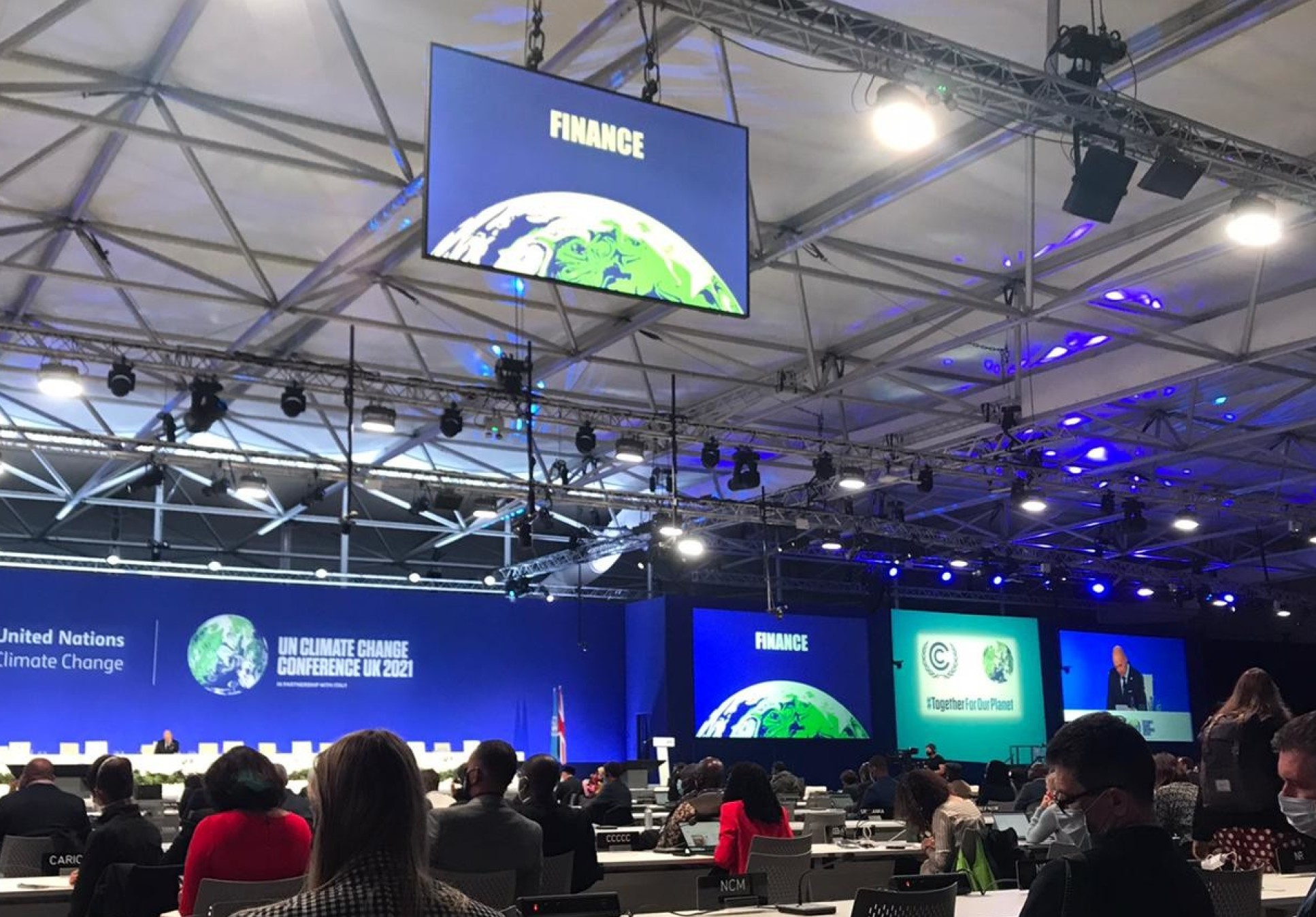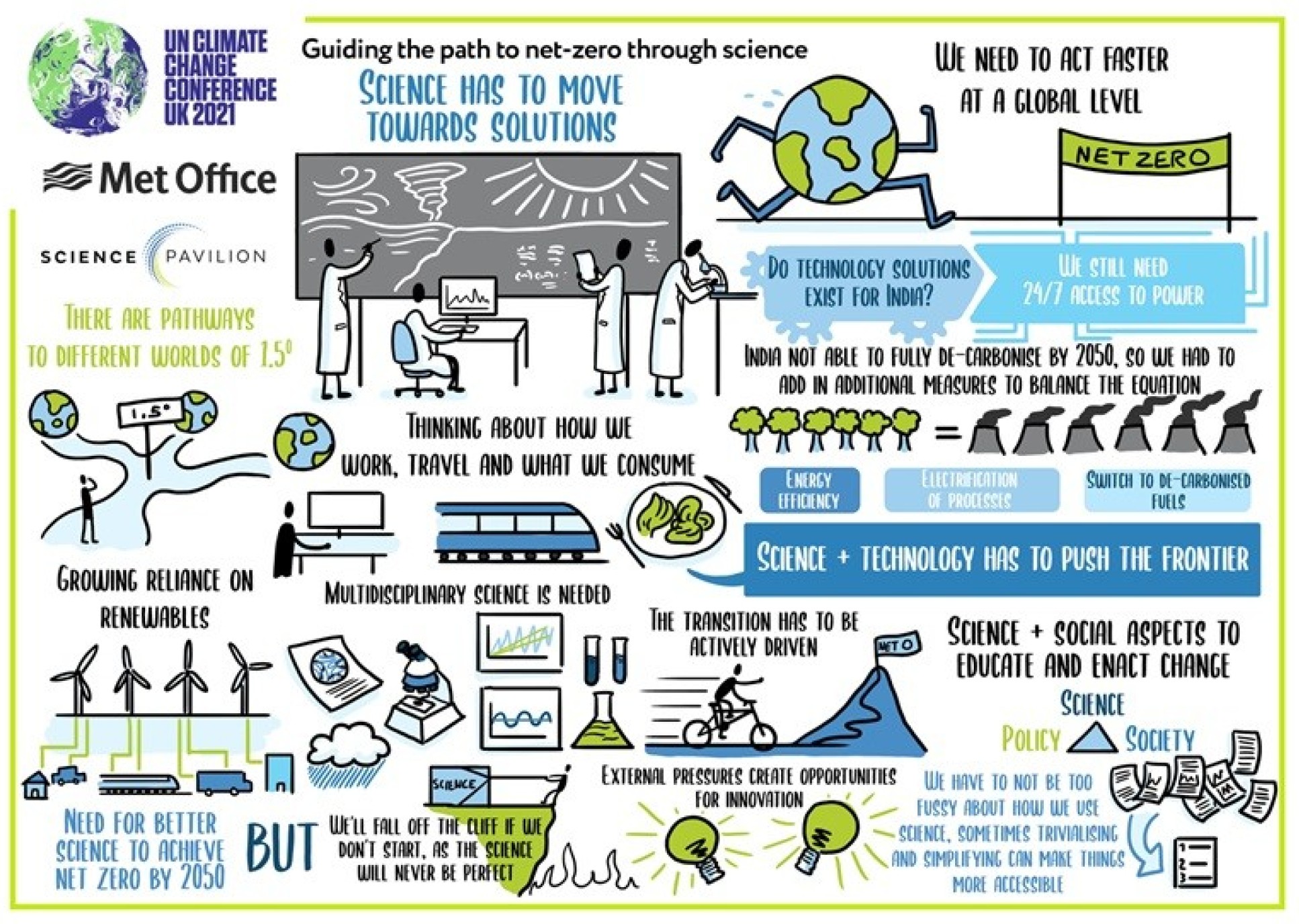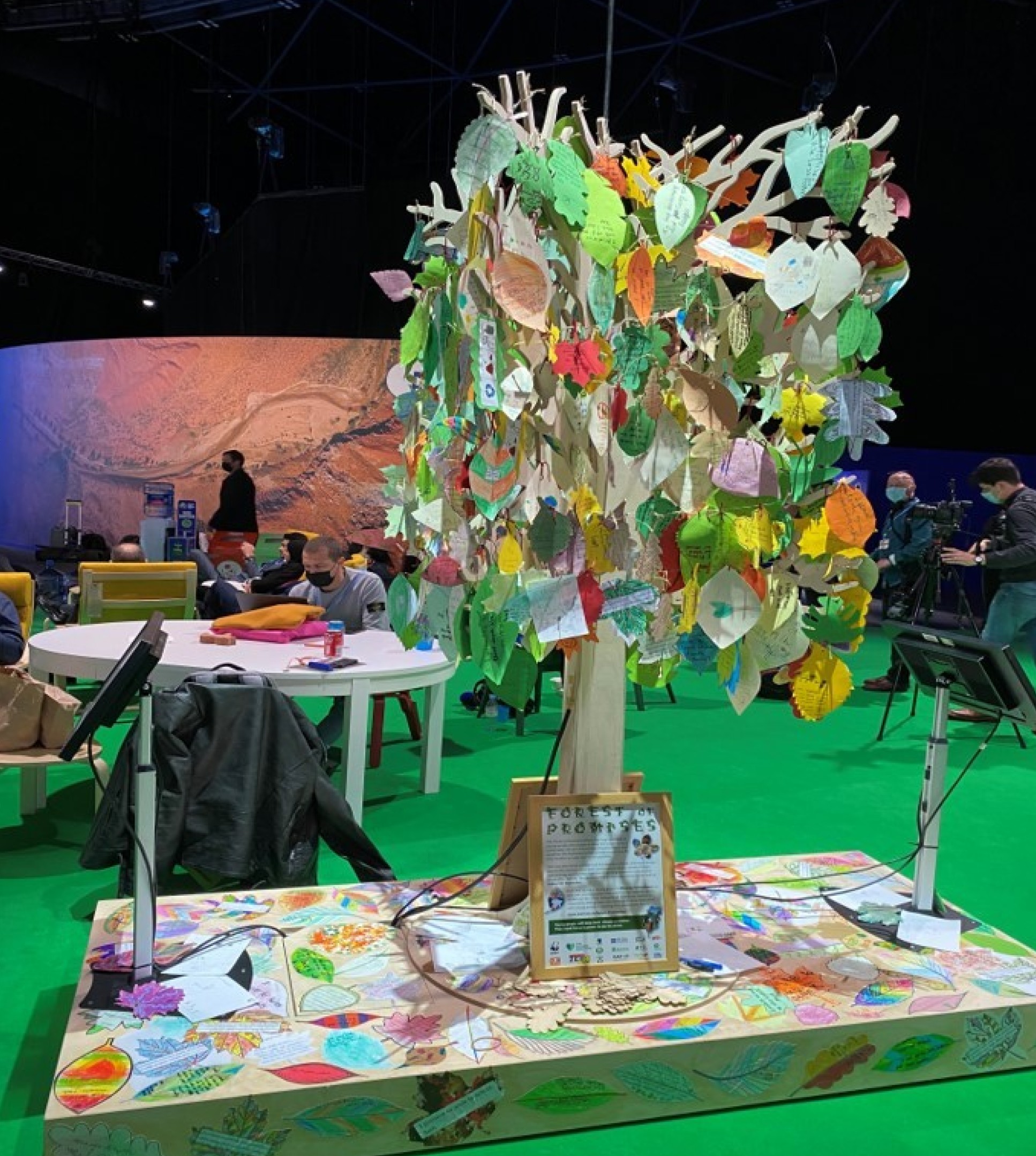
Strong words at the COP26 conference centre

Experts discuss the work that needs to happen now, after the UN climate change conference concluded with a new agreement, the Glasgow Climate Pact.
COP26, the United Nations Climate Change Conference that came to a conclusion in Glasgow this weekend, has delivered a new climate pact that was agreed by more than 190 countries that have signed up to the Paris Agreement on climate change.
The conference saw the UK Presidency finalise an agreement where all signatories acknowledged, for the first time, that burning fossil fuels (coal, oil and gas) is warming the planet and causing our climate to change.
Countries also agreed the long-discussed Paris Rulebook, a set of important technical guidelines to implement the Paris Agreement, including guidance on carbon trading; common timeframes for countries’ emissions reduction targets; and guidelines on transparency.
However, many were disappointed by the shortfall in countries’ pledges to cut their emissions, known as their ‘Nationally Determined Contributions’ (NDCs), which scientists say still do not put the world on track for the Paris Agreement goal of keeping global temperatures to 1.5°C above pre-industrial levels.

Dr Fredi Otto, Senior Lecturer at the Grantham Institute – Climate Change and the Environment, said: “1.5°C is not dead, but pledges do not reduce emissions, only national policies do, and they have to be implemented. So, it’s a Schrödinger’s cat situation in that it’s dead and alive for now – and we’ll only know which it really is when we measure emissions in the coming years.”
Another critically important part of the COP26 negotiations was the issue of climate justice, and finance from developed countries to help developing countries adapt to the impacts of climate change, as well as compensate for what is known as ‘loss and damage’ – those impacts that cannot be adapted to, such as hurricanes destroying homes, or island nations disappearing due to sea level rise.
COP26 saw progress on acknowledging the importance of this finance and the responsibility of developed countries to provide it, but many developing countries were left frustrated with a lack of tangible outcomes.
Alyssa Gilbert, Director of Policy and Translation at the Grantham Institute, said: “At an international stage, loss and damage was a bigger and clearer discussion in this COP than I have seen previously, but still not addressed head on. This topic will remain essential to developing nations and an international compromise is not clear yet.”
For experts at Imperial College London, a delegation of whom attended the climate summit as official observers of the process, the opportunity to meet activists, business representatives and policymakers from all over the world has sparked new discussions and ideas.

In this piece, they consider what the Glasgow Climate Pact means for their ongoing work to bring about a greener, cleaner, fairer future for all, and emphasise the importance of rapid, immediate action to deliver on the outcomes of COP26, and close the gaps and shortfalls it left behind.
Emission reduction pledges

 Professor Martin Siegert, Co-Director of the Grantham Institute, said: “Whereas the Paris COP21 in 2015 was characterised by a huge wave of enthusiasm for the 'Nationally-Determined' first steps towards decarbonisation, Glasgow COP26 has been a sobering meeting where we acknowledged that much more global ambition is needed if we are to avoid the worst consequences of dangerous climate change.
Professor Martin Siegert, Co-Director of the Grantham Institute, said: “Whereas the Paris COP21 in 2015 was characterised by a huge wave of enthusiasm for the 'Nationally-Determined' first steps towards decarbonisation, Glasgow COP26 has been a sobering meeting where we acknowledged that much more global ambition is needed if we are to avoid the worst consequences of dangerous climate change.
“Certainly, the next attempt to raise ambition cannot wait another 6 years – and one outcome from Glasgow will be more regular updates to carbon reduction targets. Such meetings may succeed if non-State actors and Governments work together to form not just 'pledges' but comprehensive plans for rapid decarbonisation that are supported by their citizens.”
 Professor Sir Brian Hoskins, Chair of the Grantham Institute, added: “Overall, COP26 achieved as much as I realistically expected, with some pluses and some minuses. However, the crucial tests of all the words spoken and promises made are: will the global greenhouse gas emission curve reach a maximum by the middle of this decade and then start to fall? Are the developed countries now going to give substantial help to developing countries to cope with damage due to climate change and to pursue low carbon growth?”
Professor Sir Brian Hoskins, Chair of the Grantham Institute, added: “Overall, COP26 achieved as much as I realistically expected, with some pluses and some minuses. However, the crucial tests of all the words spoken and promises made are: will the global greenhouse gas emission curve reach a maximum by the middle of this decade and then start to fall? Are the developed countries now going to give substantial help to developing countries to cope with damage due to climate change and to pursue low carbon growth?”
 Looking ahead, Dr Ajay Gambhir, Advanced Research Fellow at the Grantham Institute, commented: “[The updated pledges] signal a pathway to a less than 2°C warmer world for the first time, which is hugely encouraging. But that has to be contrasted with the fact that emissions continue to rise, so it’s now critically important that the policies and measures to deliver the envisaged peak and then rapid fall in emissions are put in place all over the world.”
Looking ahead, Dr Ajay Gambhir, Advanced Research Fellow at the Grantham Institute, commented: “[The updated pledges] signal a pathway to a less than 2°C warmer world for the first time, which is hugely encouraging. But that has to be contrasted with the fact that emissions continue to rise, so it’s now critically important that the policies and measures to deliver the envisaged peak and then rapid fall in emissions are put in place all over the world.”
 Professor Ralf Toumi, Co-Director at the Grantham Institute, added: “The CO2 in the atmosphere is the ultimate verdict on all our efforts.”
Professor Ralf Toumi, Co-Director at the Grantham Institute, added: “The CO2 in the atmosphere is the ultimate verdict on all our efforts.”
Climate finance and justice

 Izhar Shah, Research Associate at the Department of Civil and Environmental Engineering, said: “It is clear that the climate conscience is back in policymaking […] Globally speaking, I see a divided house between developed and developing countries. What I'd like to see is developed countries providing technological and financial assistance to developing economies.”
Izhar Shah, Research Associate at the Department of Civil and Environmental Engineering, said: “It is clear that the climate conscience is back in policymaking […] Globally speaking, I see a divided house between developed and developing countries. What I'd like to see is developed countries providing technological and financial assistance to developing economies.”
 Dr Fredi Otto, Senior Lecturer in Climate Science at the Grantham Institute, commented on the COP26 outcomes on climate finance:
Dr Fredi Otto, Senior Lecturer in Climate Science at the Grantham Institute, commented on the COP26 outcomes on climate finance:
“The weak outcome on loss and damages […] shows that climate change is still mainly regarded as a future problem in anything other than rhetoric. The developed states are still not prepared to take responsibility for what has happened already and that is a problem, the next COP really needs to move forward on climate justice which is not just inter-generational.”
 On important next steps, Courtnae Bailey, Research Postgraduate on the Science and Solutions for a Changing Planet DTP, commented:
On important next steps, Courtnae Bailey, Research Postgraduate on the Science and Solutions for a Changing Planet DTP, commented:
“Doubling adaptation finance from 2019 levels [as agreed in the COP26 text] is great, but this still does not fill the adaptation finance gap.” She continued: “The private sector needs to be engaged in financing adaptation for the scale of finance needed to flow. Governments therefore need to start rewarding investment in resilience and sustainability.”
 In agreement that despite the steering for more finance towards adaptation, more technical know-how and deeper understanding is needed of what works successfully, Alyssa Gilbert highlighted:
In agreement that despite the steering for more finance towards adaptation, more technical know-how and deeper understanding is needed of what works successfully, Alyssa Gilbert highlighted:
“Similarly, just transitions are an essential part of the discussion. Recognised very clearly in Glasgow, but also lacking funding and, perhaps like adaptation, it is still not clear what a just transition really looks like – which could be very different in different parts of the world. This will remain an important area for development.”
Nature and biodiversity
 Patrick Walkden, a Research Postgraduate on the Science and Solutions for a Changing Planet DTP (SSCP DTP) at the Natural History Museum and Imperial college, highlighted that at COP26, “there was finally some recognition of the interconnectedness of both the climate and biodiversity crises and that there are synergies in addressing both.”
Patrick Walkden, a Research Postgraduate on the Science and Solutions for a Changing Planet DTP (SSCP DTP) at the Natural History Museum and Imperial college, highlighted that at COP26, “there was finally some recognition of the interconnectedness of both the climate and biodiversity crises and that there are synergies in addressing both.”
 Fellow SSCP DTP Postgraduate Researcher Galina Jönsson agreed that “despite being long overdue, officially recognising the crucial role of ‘protecting, conserving and restoring ecosystems and nature’ in tackling climate change is a leap in the right direction.”
Fellow SSCP DTP Postgraduate Researcher Galina Jönsson agreed that “despite being long overdue, officially recognising the crucial role of ‘protecting, conserving and restoring ecosystems and nature’ in tackling climate change is a leap in the right direction.”
 For Senior Lecturer Dr Bonnie Waring, “one thing is certain: meeting net zero goals will necessitate not only protection of existing forest, but also the recovery and restoration of areas deforested in the past. There is a very urgent need for the ecological community, working in concert with local stakeholders, to provide data and tools that can guide best practices for restoration efforts. We must also provide rigorous ways to explore potential synergies or trade-offs among the different ecosystem services forests provide.”
For Senior Lecturer Dr Bonnie Waring, “one thing is certain: meeting net zero goals will necessitate not only protection of existing forest, but also the recovery and restoration of areas deforested in the past. There is a very urgent need for the ecological community, working in concert with local stakeholders, to provide data and tools that can guide best practices for restoration efforts. We must also provide rigorous ways to explore potential synergies or trade-offs among the different ecosystem services forests provide.”
Postgraduate Researcher Galina emphasised that future action must “bridge the gap between the climate and biodiversity agendas. Currently, climate change and global biodiversity loss have separate international conventions (UNFCCC and CBD, respectively). The vital next step is to enable a unified approach where international goal and targets are well-informed and appropriately implemented to simultaneously tackle both crises and avoid finding ourselves with divergent goals and targets that should be tackled under one banner, where progress towards one can be at the expense of the other.”
Fossil fuels

 Krista Halttunen, a Postgraduate Researcher on the SSCP DTP, emphasised that “COP26 was the first time that fossil fuels were explicitly mentioned in a climate agreement. Even though the final language on coal ‘phase-down’ and ‘inefficient’ fossil fuel subsidies is not particularly strong, the deal still sends a signal to investors and markets that fossil fuels may not be a good investment for the future.” Additionally, “the last-minute change of phrasing highlights the need to include developing country perspectives in the discussion about the future of fossil fuels, specifically how to map out realistic pathways for phasing out incumbent industries. I hope to include this perspective more in my future research as well.”
Krista Halttunen, a Postgraduate Researcher on the SSCP DTP, emphasised that “COP26 was the first time that fossil fuels were explicitly mentioned in a climate agreement. Even though the final language on coal ‘phase-down’ and ‘inefficient’ fossil fuel subsidies is not particularly strong, the deal still sends a signal to investors and markets that fossil fuels may not be a good investment for the future.” Additionally, “the last-minute change of phrasing highlights the need to include developing country perspectives in the discussion about the future of fossil fuels, specifically how to map out realistic pathways for phasing out incumbent industries. I hope to include this perspective more in my future research as well.”
For Krista, “the next important question is, what will a managed phase-out look like in practice, from the perspective of companies, governments and investors?”, a question which is central to her research. “I think the announcements at COP26 have paved the way for more concerted efforts and new collaborations to develop pathways and solutions in this area.”
Looking ahead, Krista said “the discussions at COP26 show that even though an energy transition will not happen overnight, fossil fuel phase-out is now firmly on the global agenda. I hope that governments, companies, and investors will take note of this and start planning for a managed transition away from fossil fuels now. Delaying the planning will only increase the risk of a sudden and disorderly transition, likely to have significant negative impacts on societies, economies and investments.”
 Paloma Ortega Arriaga, a fellow SSCP DTP Research Postgraduate, stressed that “fossil fuels should be phased out and the money spent on these should be relocated to clean energy technologies and to people who lack energy access.”
Paloma Ortega Arriaga, a fellow SSCP DTP Research Postgraduate, stressed that “fossil fuels should be phased out and the money spent on these should be relocated to clean energy technologies and to people who lack energy access.”
Civil society and climate change

Societal engagement with climate change – through education, local climate solutions and citizen engagement – will play an essential role in driving climate action.
 Commenting on the role of climate education in the agreements made at COP26, Dr Vasiliki Kioupi, Research Associate at the Centre for Environmental Policy, said: “This COP26 demonstrated that education for climate action and sustainability should not only be the priority of education ministries but of environment and other ministries as well and that cooperation among them is crucial for policy coherence and enabling the urgent action needed.”
Commenting on the role of climate education in the agreements made at COP26, Dr Vasiliki Kioupi, Research Associate at the Centre for Environmental Policy, said: “This COP26 demonstrated that education for climate action and sustainability should not only be the priority of education ministries but of environment and other ministries as well and that cooperation among them is crucial for policy coherence and enabling the urgent action needed.”
 Dr Neil Jennings, Partnership Development Manager at the Grantham Institute, stressed the importance of engaging everyone in the journey to reduce emissions:
Dr Neil Jennings, Partnership Development Manager at the Grantham Institute, stressed the importance of engaging everyone in the journey to reduce emissions:
“Although the level of public support for climate action is very high, it still remains a significant challenge to implement emission reductions on the scale and speed necessary while keeping all the public on board. This challenge points to the importance of deliberative democratic approaches for guiding local climate action and to focusing on the principles of a Just Transition – ensuring that the shift to a low carbon economy is well planned and that no one is left behind.”
 Dr Emma Lawrance, Mental Health Innovations Fellow at the Institute of Global Health Innovation, said people may experience impacts on their mental health when engaging with climate change:
Dr Emma Lawrance, Mental Health Innovations Fellow at the Institute of Global Health Innovation, said people may experience impacts on their mental health when engaging with climate change:
“It's important that we can create communities that have the foundations to care for each other and our health while simultaneously acting on climate. The good news is that invariably, what is good for climate is good for people's mental health; whether reducing air pollution, more active ways of getting around, or more tree cover and biodiversity in our cities.
“We will be working with our partners around the world to create ways to learn from each other and ensure the hidden costs of climate inaction on our wellbeing, as well as the multiple benefits of climate action for healthier, fairer societies, are accounted for and heard by decision-makers.”
Representation and inclusion

With the UK Presidency committing to deliver an “inclusive COP26”, Postgraduate Researcher Paloma reflected: “since I started studying my PhD on energy access, I realised how important it is to understand and include the needs of the local communities before designing any type of intervention. COP26 has reinforced this view, because the most valuable lessons I learned and the wisest words I heard during the week I attended COP26 were from youth activists and indigenous people.
Like Paloma, Postgraduate Researcher Patrick was inspired by youth activism “especially against the backdrop of what is an incredibly slow and oftentimes demoralising process, it injected much need enthusiasm and inspiration, giving hope that we can begin to hold governments and corporations to account so that they can bring down emissions and move towards greater sustainability.”
However, Paloma highlighted that youth and indigenous groups “were underrepresented, and on many occasions, overlooked by decision makers, media and other people attending COP26. I really believe that we need to give them the space and attention they deserve and include them more in the process.”
Postgraduate Galina agreed, emphasising that COP is “the only formal democratic space where smaller climate-vulnerable nations have a voice and the only place where indigenous peoples, women and other groups disproportionally affected by climate change have a voice, but only when they are not locked out of the process. RINGOs, the only non-advocacy observer constituency, were also locked out. UNFCCC must ensure this is not repeated at future COPs.”
Reflecting on the UK Presidency, Alyssa Gilbert said: “It was hugely inspiring to have a COP hosted by my home country. The locality meant that the discourse influenced people across the nation, spurred on by greater media attention, and the UK as hosting government was forced, even if too briefly, to make climate change issues central to other policy areas and commitments. I had underestimated how powerful this effect can be.”
Article text (excluding photos or graphics) © Imperial College London.
Photos and graphics subject to third party copyright used with permission or © Imperial College London.
Reporters

Hana Amer
Business School
Simon Levey
Communications Division

Contact details
Email: s.levey@imperial.ac.uk
Show all stories by this author
Katrine Petersen
The Grantham Institute for Climate Change

Contact details
Email: press.office@imperial.ac.uk
Show all stories by this author
Siobhan Stack-Maddox
Human Resources Division

Contact details
Email: press.office@imperial.ac.uk
Show all stories by this author





Leave a comment
Your comment may be published, displaying your name as you provide it, unless you request otherwise. Your contact details will never be published.